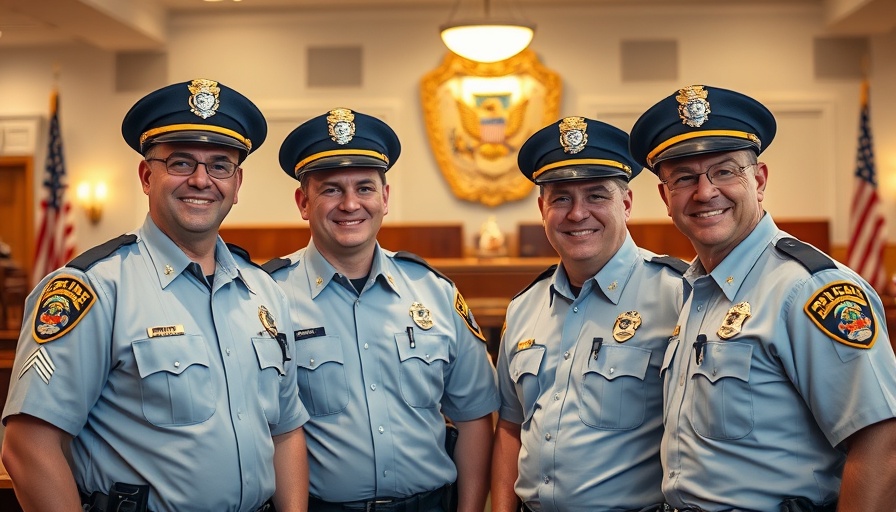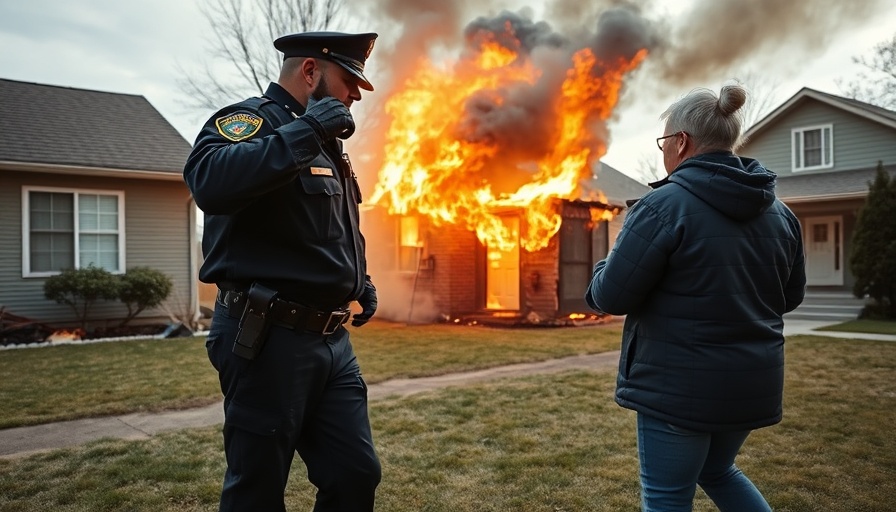
Knife Attack in Illinois Car Dealership Sparks Officer-Involved Shooting


Police AED Initiatives: Officer Saves Life in 48 Hours with New Technology
Update A Life-Saving Initiative: The Impact of AEDs in Law Enforcement In a remarkable demonstration of effective public safety measures, Alexandria Police Officer Whitney Buerger saved a man’s life just two days after a new public safety initiative rolled out across Northern Kentucky—where automated external defibrillators (AEDs) were equipped in every police cruiser. This initiative comes in response to the growing need for emergency medical tools in the field, especially following high-profile cardiac incidents. Transformative Impact of Public-Private Partnerships The deployment of AEDs was not just an isolated effort; it exemplifies a collaborative approach between law enforcement, healthcare systems, and community organizations. The project began after the widely publicized cardiac arrest of NFL player Damar Hamlin, which sparked conversations within community groups and evolved into significant investment and deployment of lifesaving devices across the region. With funding from local healthcare partners, a total of 168 Avive Connect AEDs were strategically allocated to 38 agencies across six counties. A Personal Connection to Life-Saving Technology For Officer Buerger, the AED was particularly meaningful—she is a survivor of a cardiac arrest herself. When responding to an emergency call on November 15, 2024, she quickly retrieved an AED and administered a shock to restore the pulse of a man named Matt, moments after his partner initiated CPR. Notably, she provided lifesaving care without formal training on the device. Buerger highlighted, “The AED is more than just compressions... It’s letting us know we’re doing the right thing.” This story illustrates not only the technology’s potential but its ability to engage officers on a personal level, reminding them of the human lives at stake. Immediate Results: Proving the Effectiveness of AED Deployment The quick success of the initiative—a confirmed save just 48 hours post-deployment—demonstrates the critical difference that having AEDs accessible can make in emergency situations. Garren Colvin, CEO of St. Elizabeth Healthcare, noted, “This project shows what’s possible when law enforcement, healthcare, and community leaders work together.” His sentiment underscores the importance of backlog resources and the need for continuous support for law enforcement, especially in emergency medical response scenarios. Future Considerations: Expanding Knowledge and Resources As law enforcement agencies across the nation assess their public safety protocols, it's essential to consider the integration of similar initiatives. The value of AEDs in police cruisers not only enhances the safety of the communities served but significantly impacts officer wellness as well. Knowledge about emergency medical devices, including AEDs, should be a cornerstone of police training programs. Ensuring that all officers receive comprehensive training on the operation and best practices regarding AEDs could further increase the effectiveness of these life-saving interventions. Community Engagement and Building Trust This initiative also presents an opportunity for police departments to engage with their communities. By openly communicating about the deployment of AEDs and demonstrating their efficacy, law enforcement can enhance public awareness and trust. Initiatives that involve active community participation not only foster goodwill but prepare citizens to respond effectively in emergency situations. The success of Officer Whitney Buerger in reviving a cardiac arrest victim serves as a powerful narrative of the potential outcomes that result from proactive measures like the deployment of AEDs in law enforcement agencies. As public safety continues to evolve, innovative technologies and public-private partnerships will be critical in defining how law enforcement can continue to protect and serve more effectively. It is vital that communities advocate for continued investment in such life-saving resources and measures. In conclusion, initiatives like these exemplify a forward-thinking approach to public safety, which recognizes that technology and community partnerships can save lives. Departments must prioritize policies that not only equip officers with the right tools but also ensure they are trained to use them confidently, ultimately enhancing community relations and promoting safer environments for everyone.

N.J. Officers Heroically Rescue Child from Burning House in Dramatic Catch
Update Bravery in Action: N.J. Officers Save Young Life In a heart-pounding incident that underscores the valor of local law enforcement, officers from the Asbury Park Police Department successfully caught an 8-year-old boy leaping from the second floor of a burning house. This remarkable rescue transpired on August 30, 2025, and was captured on video, showcasing how quick thinking and training saved a life. Real-World Training Meets Emergency Response Asbury Park Police Director John B. Hayes praised the swift action of Officers Dewitt Bacon and John Walsh, along with local resident Joseph Dunbar. “Asbury Park police officers train for fast-moving, dangerous situations, and yesterday’s rescue shows the value of that training and the strength of our community,” he stated. This incident emphasizes the role of realistic training scenarios in police preparation, illustrating how officers adapt their skills under pressure. The Human Element: Community and Courage This event wasn't just a reflection of police training; it also highlighted a community coming together in a moment of crisis. Joseph Dunbar’s instinctive decision to help catch the boy reveals how local residents can play critical roles in emergency situations. Such collaborations between police and community members can foster trust and engagement, improving police-community relations. Importance of Officer Preparedness and Community Cooperation The bravery displayed by both the officers and the civilian is noteworthy but serves as a reminder of the ongoing discussions about officer safety and preparedness. With public safety concerns guiding law enforcement policies, it is crucial they are equipped with both the physical tools and psychological resilience necessary to manage crises effectively. Implications for Future Training and Recruitment Strategies As police departments review their training programs, instances like this can inspire enhancements to curricula. Incorporating real-world rescue scenarios involving community participation could prepare officers for unpredictable emergencies. Furthermore, such heroics can aid in police recruitment efforts, emphasizing a career that not only focuses on law enforcement but also on community service. Taking Action: Investing in Future Officers and Communities It’s essential that policymakers and law enforcement leaders recognize the significance of investing in effective training programs that incorporate community involvement. These investments bolster both officer safety and public relations, ensuring that the community feels supported while officers remain prepared for emergencies. Encouraging proactive responses can foster environments where citizens and police departments work in tandem to ensure safety. The Bigger Picture: Enhancing Public Safety The Asbury Park rescue incident draws attention to the overarching theme of public safety, where law enforcement technology and training must intersect with the needs of the community. Improved training methods, alongside open channels of communication with the public, can help address concerns around police practices and community trust. This incident is a testament to the necessity of ongoing discussions around public safety, police accountability, and community relationships. As we reflect on these events, let’s champion proactive steps that contribute to a safer and more engaged society.

Rethinking Policing Strategies: A Bold Solution to Reduce Homelessness
Update Rethinking Our Approach to Homelessness The rise of homelessness across America has become an inescapable truth that demands urgent action. This crisis not only impacts the individuals experiencing homelessness but also has convoluted effects on communities, law enforcement, and public resources. Astonishing figures reveal that police officers are often overwhelmed with calls related to homelessness, taking away time and resources from critical policing efforts. In California, where the issue is most pronounced, $17.5 billion has been spent on combating homelessness in the past four years, yet the numbers continue to rise, highlighting a significant disconnect in strategy and execution. The Real Roots of Homelessness Contrary to popular belief, the main driver of homelessness isn’t simply the lack of housing; it stems from the breakdown of social relationships. The example shared by Deputy Micah Hope in Cloverdale, where a homeless individual merely sought a shopping cart, underscores a vital truth: homelessness is often a symptom of deeper societal neglect. As illustrated by the continued struggles of individuals despite robust efforts and funding, it’s time to acknowledge that we need to address the core social issues that contribute to homelessness rather than tackling the superficial manifestations. Innovative Solutions: Community-Led Initiatives The idea that local law enforcement agencies can lead a community-wide solution offers a hopeful avenue for addressing these deep-rooted issues. Community engagement can be a powerful tool in rebuilding these lost connections and providing support to the homeless. Instead of merely relocating homeless individuals or issuing citations, law enforcement can foster partnerships with social services to create sustainable solutions that prioritize healing relationships. Future Predictions: The Role of Public Policy In the rapidly evolving landscape of public safety policy, there’s an opportunity for transformative change. Policymakers have the chance, now more than ever, to pivot from ineffective spending to holistic approaches that empower individuals. By reorienting public resources towards programs that mend relationships—such as community outreach, rehabilitation services, and preventative measures—we can turn the tide on the rising numbers of homelessness. Engaging in proactive problem-solving rather than reactive policing can significantly uplift community well-being. Tangible Actions: Reimagining Taxpayer Dollars What if we redirected the billions spent on temporary fixes into innovative community programs? Investments in relationship restoration initiatives, family reunification, and comprehensive mental health services could be immensely beneficial. These strategies not only promise better outcomes for individuals but also reduce police time spent on homelessness-related calls, allowing officers to focus on core public safety responsibilities. The Bottom Line: A Call to Action for Policymakers and Law Enforcement For police departments, policymakers, and community leaders, embracing a new paradigm is essential to effectively tackle the homelessness crisis. It’s necessary to engage communities in crafting answers that go beyond mere statistics and strive toward rebuilding lives. Real change requires collaborative efforts and an understanding that fostering trust, accountability, and empathy within our communities is key to enhancing public safety and effectively combating homelessness.
 Add Row
Add Row  Add
Add 

 Add Element
Add Element
Write A Comment